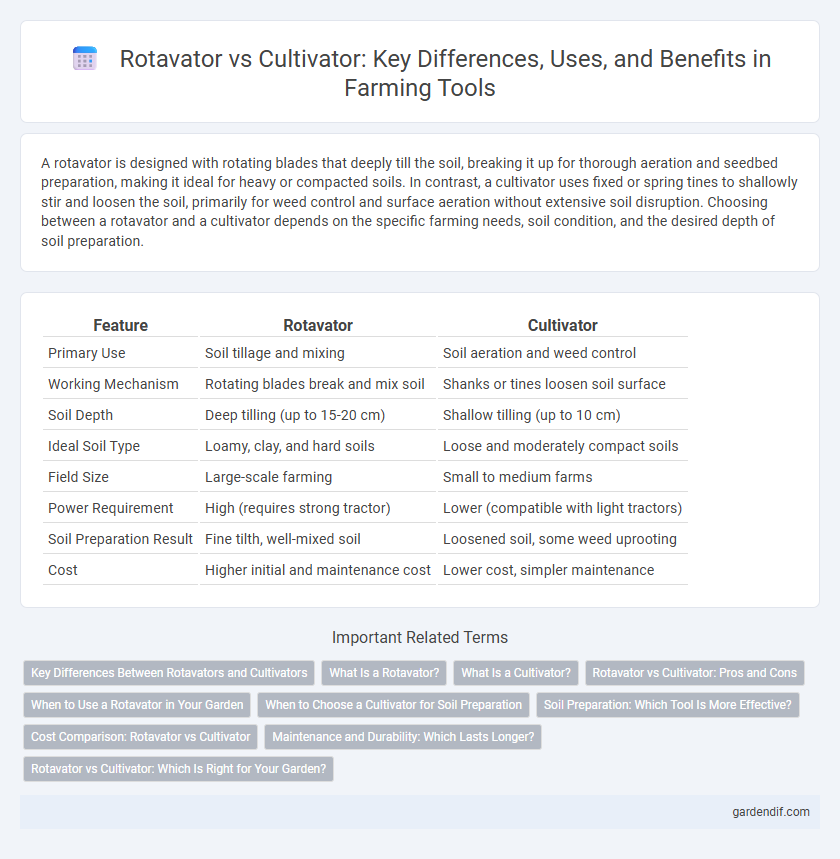
Rotavator vs Cultivator Illustration
A rotavator is designed with rotating blades that deeply till the soil, breaking it up for thorough aeration and seedbed preparation, making it ideal for heavy or compacted soils. In contrast, a cultivator uses fixed or spring tines to shallowly stir and loosen the soil, primarily for weed control and surface aeration without extensive soil disruption. Choosing between a rotavator and a cultivator depends on the specific farming needs, soil condition, and the desired depth of soil preparation.
Table of Comparison
| Feature | Rotavator | Cultivator |
|---|---|---|
| Primary Use | Soil tillage and mixing | Soil aeration and weed control |
| Working Mechanism | Rotating blades break and mix soil | Shanks or tines loosen soil surface |
| Soil Depth | Deep tilling (up to 15-20 cm) | Shallow tilling (up to 10 cm) |
| Ideal Soil Type | Loamy, clay, and hard soils | Loose and moderately compact soils |
| Field Size | Large-scale farming | Small to medium farms |
| Power Requirement | High (requires strong tractor) | Lower (compatible with light tractors) |
| Soil Preparation Result | Fine tilth, well-mixed soil | Loosened soil, some weed uprooting |
| Cost | Higher initial and maintenance cost | Lower cost, simpler maintenance |
Key Differences Between Rotavators and Cultivators
Rotavators feature rotating blades that break up soil into fine tilth, enhancing aeration and seedbed preparation, while cultivators use fixed or spring-loaded tines to loosen soil and control weeds without extensive soil pulverization. Rotavators are ideal for primary tillage in heavy, compacted soils, whereas cultivators perform better in secondary tillage for maintaining moisture and weed control. The difference in blade design and soil interaction makes rotavators more aggressive and cultivators more precise in field management.
What Is a Rotavator?
A rotavator is a powerful agricultural tool equipped with rotating blades designed to break up, mix, and aerate soil efficiently. Unlike a cultivator that primarily stirs and loosens soil, a rotavator's rotary tilling action can prepare seedbeds by pulverizing hardened ground and incorporating organic matter deeply. This tool is essential for large-scale farming operations requiring thorough soil preparation for planting crops.
What Is a Cultivator?
A cultivator is an agricultural tool designed to prepare soil by loosening and aerating it, promoting better water absorption and root growth. Unlike a rotavator that deeply tills the soil, cultivators primarily work the surface layer, removing weeds and mixing soil without disturbing the underlying layers extensively. This makes cultivators ideal for maintaining soil health and preparing seedbeds in gardens and farms.
Rotavator vs Cultivator: Pros and Cons
Rotavators provide deep soil mixing and effective weed control with fast operation, making them ideal for initial soil preparation but they consume more fuel and require skilled handling. Cultivators offer shallow tillage, preserving soil structure and moisture while being fuel-efficient and easier to operate, though they are less effective in heavy weed infestation or hard soil. Choosing between rotavator and cultivator depends on soil conditions, crop requirements, and fuel considerations.
When to Use a Rotavator in Your Garden
A rotavator is ideal for breaking up compacted soil and preparing large garden beds quickly, making it perfect for initial soil cultivation before planting. Use a rotavator when you need to mix organic matter or fertilizers evenly into the soil, enhancing nutrient distribution and improving soil aeration. Avoid using a rotavator in small or delicate garden areas where precision is required, as its aggressive digging action can damage roots and existing plants.
When to Choose a Cultivator for Soil Preparation
Choose a cultivator for soil preparation when working with lighter soils or for shallow tillage, as it efficiently breaks up soil clumps and aerates the soil surface without causing excessive disturbance. Cultivators are ideal for weed control between rows and for mixing crop residues into the topsoil to improve organic matter content. They are preferred in garden beds or smaller plots where precision and minimal soil disruption are crucial for healthy seedbed preparation.
Soil Preparation: Which Tool Is More Effective?
Rotavators provide deeper soil tillage by using rotating blades that break up compacted soil layers, enhancing aeration and root penetration. Cultivators, equipped with spring tines or discs, perform shallow soil cultivation ideal for weed control and mixing surface residues without disturbing soil structure extensively. For intensive soil preparation and primary tillage, rotavators are more effective, whereas cultivators excel in secondary tillage and soil conditioning tasks.
Cost Comparison: Rotavator vs Cultivator
Rotavators generally have a higher upfront cost compared to cultivators due to their complex design and enhanced soil preparation capabilities. Maintenance expenses for rotavators tend to be greater as well, involving more frequent replacement of blades and parts. Conversely, cultivators offer a more cost-effective solution with lower purchase prices and reduced maintenance demands, making them ideal for smaller-scale or budget-conscious farming operations.
Maintenance and Durability: Which Lasts Longer?
Rotavators generally require more frequent maintenance due to their complex rotating blades and moving parts compared to cultivators, which have simpler tines and less mechanical stress. Cultivators tend to be more durable over time, with sturdy construction that withstands rough soil conditions and requires minimal upkeep. Choosing between a rotavator and cultivator involves balancing the intensive maintenance needs of rotavators with the long-lasting reliability of cultivators.
Rotavator vs Cultivator: Which Is Right for Your Garden?
A rotavator is ideal for breaking up hard soil quickly with its rotating blades, making it perfect for heavy-duty soil preparation and large gardens. Cultivators are better suited for lighter tasks, such as aerating soil and mixing compost in smaller garden beds. Choosing between a rotavator and a cultivator depends on your garden size, soil condition, and the type of soil work required.
Rotavator vs Cultivator Infographic

 gardendif.com
gardendif.com